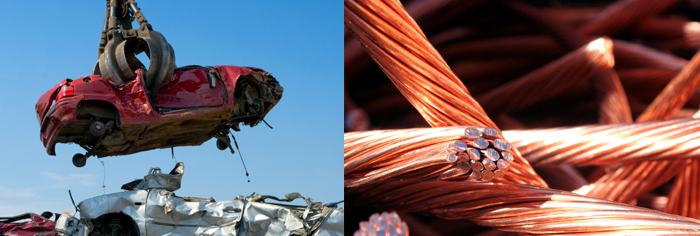It’s one of the most frequently asked questions we get in the scrap industry: “So what’s the difference between ferrous and non-ferrous materials, anyway?” The answer is actually pretty simple. What those differences mean when it comes to the buying and selling of scrap material, however, takes a bit more explaining.

The short answer
Ferrous metals and alloys contain iron; non-ferrous materials do not. If the question happens to come up during a trivia night or your appearance on a game show, you’re pretty much covered. But it’s not so easy to tell when just looking at a random piece of metal. Luckily, there are several other factors that differentiate the two.
The characteristics of ferrous metals
Ferrous metals include mild steel, carbon steel, stainless steel, cast iron, and wrought iron. These metals are primarily used for their tensile strength and durability, especially mild steel which helps hold up the tallest skyscrapers and the longest bridges in the world. You can also find ferrous metals in housing construction, industrial containers, large-scale piping, automobiles, rails for railroad and transportation, most of tools and hardware you use around the house, and the knives you cook with at home.
Due to the high amounts of carbon used when creating them, most ferrous metals and alloys are vulnerable to rust when exposed to the elements. While this isn’t true of wrought iron, which is so iron pure that it resists oxidization, or stainless steel, which is protected thanks to its high chromium content, it’s a good rule of thumb that if you see rust, it’s a ferrous metal.
Most ferrous metals also have magnetic properties, which makes them very useful in the creation of large motors and electrical appliances. The reason you can tack your child’s artwork to the refrigerator with that magnet with the local pizza place’s phone number on it? Ferrous metal.
Most importantly, ferrous metals make up the most recycled materials in the world. In 2008 alone, 1.3 billion tons of steel were produced, and 500 million tons of that was made from scrap materials. But we’ll get to why that’s important a little later.
The characteristics of non-ferrous metals
Non-ferrous metals include aluminum, brass, copper, nickel, tin, lead, and zinc, as well as precious metals like gold and silver. While non-ferrous metals can provide strength, they are primarily used where their differences from ferrous metals can provide an advantage.
For instance, non-ferrous metals are much more malleable than ferrous metals. Non-ferrous metals are also much lighter, making them well-suited for use where strength is needed, but weight is a factor, such as in the aircraft or canning industries. Because they contain no iron, non-ferrous metals have a higher resistance to rust and corrosion, which is why you’ll find these materials in use for gutters, water pipes, roofing, and road signs. Finally, they are also non-magnetic, which makes them perfect for use in small electronics and as electrical wiring.
As far as recycling goes, aluminum is the third most recycled material in the world. However, many other non-ferrous materials like copper, brass and lead are relatively scarce, and metallurgists rely heavily on scrap material recycling to make new ones. Which brings us to…
The pricing difference
Whether you’re an individual scrap collector or a large company generating scrap through construction or demolition, chances are you’re interested in selling that metal off. So what can you expect when it comes to the price you’ll get for your materials?
For the most part, ferrous scrap metals tend to be in good supply, so the prices tend to be lower than most non-ferrous metals. Because steel and iron alloys are constantly being recycled in high volume all over the globe, the prices for these materials stay fairly constant on a month-to-month basis, dropping or raising only slightly.
Non-ferrous scrap, as we mentioned before, are somewhat harder to come by and more difficult to create. This makes the demand higher, which drives up the price per pound higher than ferrous metals. While aluminum prices don’t fluctuate often due to recycling efforts, others like copper and brass can change drastically in just a month’s time depending on the needs of the market.
If you’re an individual looking to sell scrap, it’s always best to check with a scrap dealer in your area to find out what prices they’re offering before you bring your materials to the yard. Feel free to give us a call to get the latest rates.
If you have an industrial, commercial, or demolition business, contact your scrap dealer and see if they’ll come out and assess your specific scrap situation. Not only will they help identify what you have, they should be able to provide an estimate for the collection and sale of your ferrous or non-ferrous materials.
But enough about differences
In the end, the greatest similarity ferrous and non-ferrous metal have is their importance to the recycling industry. By working together with your local scrap dealer to create a Scrap Management plan that helps keep the flow of both types of scrap materials steady, we can continue to create new materials that helps benefit all our lives. It’s a choice that truly makes a difference.
[ctaw id=”1515″]


